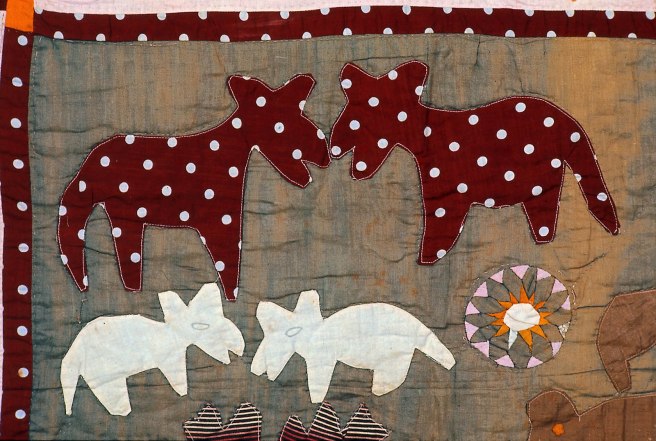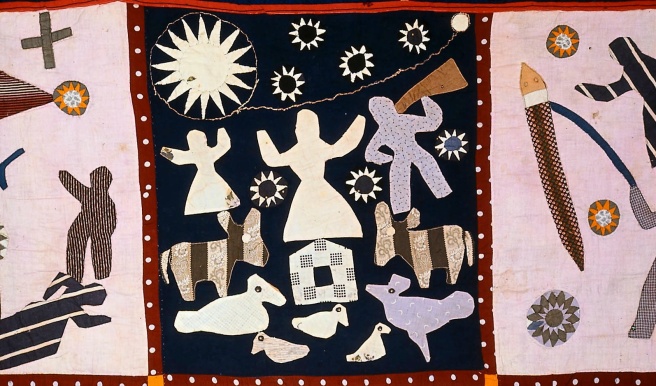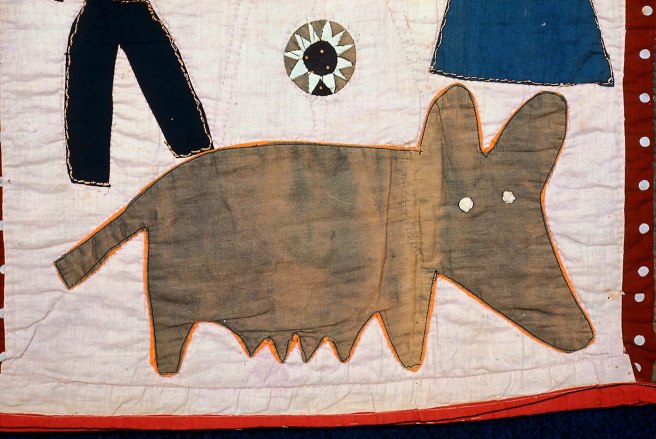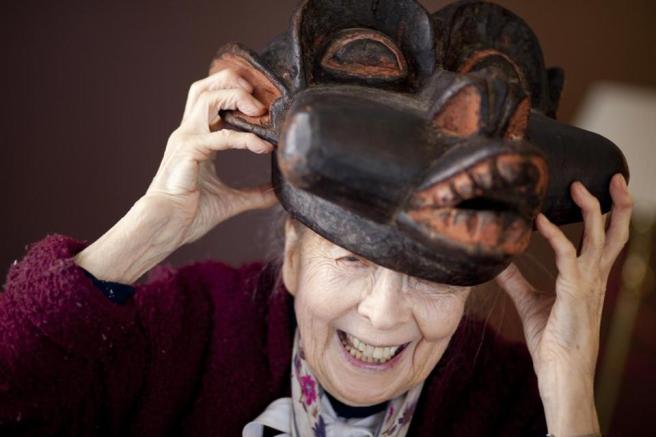

The pleasure of pulling a book off the shelf in our towering Textile and Fashion Arts library is enhanced by the occasional glimmer of some remote memory or recognition, as I open to an image, a textual passage, a name. In my search for material written about the iconic Pictorial Quilt by Harriet Powers, I located an essay in the journal Black Art, an international quarterly. The author: Marie Jeanne Adams. Then came the glimmer—I realized she was the distinguished scholar and educator of African and Oceanic art to whom I was introduced some twenty odd years ago as “Monni.”

Library, Harvard University. Web source: Tribal Arts Magazine (click image for web page).
Thus, I came to learn that Marie Jeanne Adams changed her surname at some point in her life after publishing The Harriet Powers Pictorial Quilts in Black Art, the possible reasons for which remained a mystery according to tributes published after her death. A petite woman of exceptional presence and personality, Monni’s incisive wit, energy and vitality were extraordinary and left an indelible impression. She had already reached the age of 59 when she published the essay I refer to here in 1979, long before I met her, and she never ceased contributing to the fields of anthropology and art history through her teaching, curatorial accomplishments, field research and writing. Her last paper was published in African Arts at the age of 91; she died on December 24, 2014. I was greatly pleased to have this renewed connection to Monni Adams by way of Harriet Powers and her quilts, and a chance to further explore the MFA’s textile treasure through an illuminating study.
Adams begins with a general history and description of the Pictorial Quilt (see also This I Accomplish, Part I and Part II) and places the quilt in the broader context of “folk art.” Discourse I’ve been exposed to about usage of this term and other labels such as “outsider art” points to a constellation of problematic issues relating to culturally-biased, limiting, and inaccurate representations of artists assigned to this class and the work they create. Elaborating on her frame of reference, Adams makes the following comment:
In terms of value or importance, folk art might also be called the art of powerlessness for it usually deals not with problems of power or authority or large spiritual issues but with small purposes or trivial concerns, so that it can afford to be cheerful, fanciful, unambiguous and innocuous.”

Adams’ classification of the quilt, in an essay written forty years ago, proves itself inadequate by her own admission, as we shall see later. Needless to say, my real intention here is to follow her thought process as one person seeking to comprehend and interpret the object itself through the mind and hands of the maker, Harriet Powers.
The Biblical themes in Powers’ Pictorial Quilt:, such as Job praying for his enemies (#1); Adam and Eve in the garden (#4); Jonah and the Whale (#6) and the Crucifixion of Christ (#15)—as well as scenes marking historic celestial events: The dark day of May 19, 1780 (#2); The falling of the stars on Nov. 13, 1833 (#8), and The red light night of 1846 (#12)—form the thematic subjects by which Harriet Powers gave expression to her convictions and declared her faith. Adams contends the maker gave deep thought to her compositions in the MFA’s quilt, the second of only two known quilts by Powers, demonstrating increased mastery of complexity and scale:

The scope of her interest shows in the many different kinds of motifs she introduces, representing men, women, children, large animals, birds and other small creatures, fantasy beasts of Revelations, trumpets and a bell, a house, a boat, a coffin and special symbols such as the hand of God, stars, comets, and other cosmic bodies.”
…and in the following four images, Adams looks closely at the maker’s visual vocabulary by pointing out communicative details, such as spikes of frozen breath of the mule (#11); the choice of gold metallic thread to outline the figures of Bob Johnson and Kate Bell (rich sinners, according to Powers), elaborated in a series of loops to depict a crown on Kate’s head (#13); and blood and water streaming from the side of the crucified Christ conveying a visceral experience of horrific suffering (#15).




Celestial bodies, depicted in all but one quilt square, stand out as meticulously worked elements. Quilt blocks #2, #8, and #12 in particular illustrate historic atmospheric events that occurred across the skies of the United States, stories of which spread by way of oral tradition; Adams suggests these compositions reveal Powers’ greatest gifts:
She carefully varies yet re-uses patterned cloth pieces in the appliquéd figures and repeats types of motifs, such as the heavenly bodies, devices that subtly link the scenes together…She lavishes attention on these heavenly bodies; they give the scenes their scale and aura of importance. In contrast to the other figures, each of which is formed with one piece of appliqué, the cosmic motifs are composed of tiny pieces of cloth, painstakingly fitted into sharply pointed forms of contrasting color, and sewn together by hand.”


By following Adam’s observations, from small details to broader thematic ones, and based on how the Pictorial Quilt was progressively stitched, I learned that the individual squares were connected in vertical columns. It stands to reason that Powers made deliberate choices about the arrangement of scenes. Adams’ close reading of the quilt’s visual elements and their configurations reveals that the scenes are consolidated thematically, crystallizing narrative poles of punishment and redemption; of apocalypse and salvation—spiritual concerns of scale that hardly conform to an “art of powerlessness”:
The more one examines the style and the content of Harriet Powers’ work, the more one sees that it projects a grand spiritual vision that breaks out of the confines of folk art. Pondering the pictorial content of each scene and its relationships to the others leads one to realize the depth of her concern for and how well she grasped the apocalyptic yet redemptive vision of Christian doctrine.”
If we look at quilt block #13, at the bottom of the third column, we see what is arguably the most important icon of God’s redemptive power as envisioned by Powers: “The independent hog which ran 500 miles from Georgia to Virginia…” Betts reigns supreme as the largest single figure on the quilt, foregrounding the rich sinners who await their eternal punishment (could Bob Johnson and Kate Bell have been former slave owners)? In her methodical synthesis of the connective tissue of Power’s fifteen quilt blocks, Adams locates Betts as the essential fulcrum of a dynamic narrative playing out across the surface of Harriet Powers’ creation:

Bett’s flight provides a scarcely veiled reference to the path of runaway slaves of pre-Civil War days. This image crimps together at this central point the grand meaning of the religious theme and the struggle for freedom from slavery and suggests a parallel between Mrs. Powers’ faith in the Biblical stories of deliverance and her vision of her life experience as a freed slave. Viewed in this light, juxtaposing events within the first four columns from the Old Testament and from the skies over the United States makes sense as comparable old orders. The last column stands alone as a lasting message of deliverance.”
If Betts stands as a symbol for the human struggle for freedom and the possibility of a long and hard-won journey to independence—then I observe, in higher relief, the subtle line of bright orange fabric surrounding the contours of the hog. Powers placed two layers of fabric together (laying the brownish fabric over the orange layer), stitched the outline of Betts’ body within the cut edges of the two layers, and then, with calculated attention and patience—not unlike her painstaking rendering of celestial bodies—the maker carefully trimmed the edges of each fabric layer close to her line of stitching, starting with the top layer. She chose to trim the orange layer quite close to the first, leaving just enough to reveal a glowing sliver of incandescent radiance: a clue that Betts the hog is no ordinary farm animal.

A Closer Look features in-depth posts that develop from “quick studies” by the author based on Textile and Fashion Arts collections at the MFA, Boston. As such, her deeper explorations share a correspondence with many of the objects she writes about under the category Objects in Brief.

Catherine, Thank you for your thoughtful introduction to this marvelous textile (marvelous in both style and content) through the always incisive thought of my dear, late friend Monni. She was one of those very rare people who always had something astute to say, which she accomplished in the most matter of fact way as if anyone might be capable of her insights. Of course, they are not.
Thanks for your comment Jeff, and most importantly, for introducing me to Monni-I will always remember her. I’m very glad indeed for the chance to learn more about the Powers quilt through her keen eyes and intellect – her ability to connect the smallest details to the arc of its whole helped me see the quilt in higher relief, and made me think about the many, many students she inspired throughout her career. Her work continues!